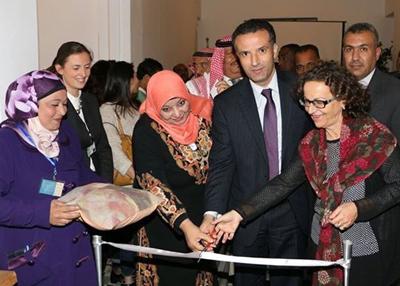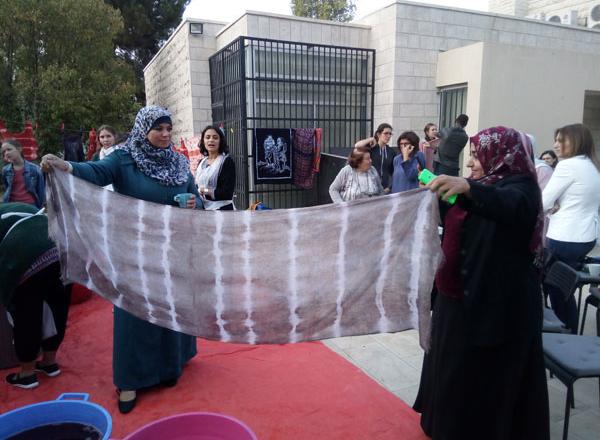You are here
‘In Jordan Valley, women turn culture into a source of resilience’
By Hind Joucka - Nov 26,2016 - Last updated at Nov 26,2016

Members of the Ghor El Safi Women’s Association have utilised natural dyes to colour their handmade fabric products (Photo courtesy of UNESCO)
AMMAN — A project that utilises the colourful soil and natural plants of Jordan to produce hand-dyed textiles in the Jordan Valley is testament to the ambition of the Kingdom to place culture and creative economy on its development agenda, according to a UN official.
Speaking at the opening ceremony on Thursday of an exhibition that showcased handcrafted and naturally dyed fabrics created by rural women from the Jordan Valley as part of an empowerment programme, UNESCO Representative to Jordan Costanza Farina said “no society can flourish without culture”.
“No development can be sustainable without it,” she added.
According to Farina, the UNESCO project opens new horizons for women’s ambitions and creates opportunities to support their communities.
Funded by Drosos Foundation, the project aims to empower rural women in Ghor Al Safi by helping them make their handicraft activities sustainable and provide them with income-generating opportunities.
The bazaar, which concluded on Saturday, presented the second phase of the Indigo Collection of “Safi Crafts”, an eco-friendly handcraft brand made by Ghor El Safi’s Women’s Association.
The exhibition came as part of a three-day event organised in celebration of the achievements of the project “Empowering Rural Women and Increasing Resilience in the Jordan Valley” in partnership with the Ghor El Safi Women’s Association.
The women of Ghor Al Safi, a small village south of the Dead Sea, have been producing hand dyed textiles using natural items such as tea leaves, pomegranate and mushroom, according to Nofeh Nawasrah, the president of the Ghor El Safi Women’s Association.
“All our products are natural and are extracted from plants by us. We are very happy that our products are being sold in numerous places, and I believe that the name of our brand is slowly but surely expanding,” she told The Jordan Times.
The colourful, vibrant and natural handcrafts “represent a genuine interpretation of culture and a telling example that culture has become already these women’s source of resilience”, Farina told The Jordan Times.
The initiative researched traditional natural dyeing techniques and re-introduced the cultivation of the indigo colour, for which the Jordan Valley used to be renowned in the past, according to Farina.
“The blue textiles displayed today are coloured using natural indigo processed for the first time since the ancient Zohara, which is the Byzantine name of Ghor Al Safi, where indigo used to be sold as a very precious good,” the UN official explained.
Nawasrah highlighted how the project has helped empower the members of the association and improve their lives.
“The ladies we work with have more self-confidence to speak up their minds and to speak publicly now,” she said.
Tourism Ministry Secretary General Issa Gammoh attended the event, representing Tourism Minister Lina Annab, and underlined the importance of similar projects in promoting tourism in the country.
“This programme comes in line with the Jordanian government’s strategy to introduce and encourage local economic development as well as create better engagement with local communities,” he said.
“We strongly believe that tourism is the best agent for economic growth and for helping Jordanians’ welfare and their standards of living,” Gammoh added.
The event included a display of “Safi Crafts” products as well as entertainment for children, lectures on the colour indigo and workshops on natural dyes, and the preparation of typical home-made food from the Southern Jordan Valley.
Related Articles
AMMAN — UNESCO on Wednesday launched an exhibition of handcrafted and naturally dyed fabrics created by rural women from the Jordan Valley a
Amman — The Ghor Al Safi Women’s Association, a group of women from the Jordan Valley producing dyed textiles in collaboration with Tiraz Ce
Three experts from Oman concluded a five-day visit to Jordan on Thursday during which they shared their expertise on the ancient tradition of indigo harvesting, processing and dyeing with members of Ghor El Safi Women’s Association, according to a UNESCO statement.

















